Numerical Simulation of Mechanical Properties of Soil Considering the Effect of Internal Erosion
Abstract
1. Introduction
2. Research Significance
3. Numerical Model
3.1. Overview of the PFC3D
3.2. Assignment of Contact Model
3.3. Numerical Modeling
3.4. Numerical Simulations
4. Results, Discussion, and Analysis
4.1. Analysis of Void Ratio Variation
4.2. Analysis of Deviatoric Stress-Volumetric Strain-Axial Strain Curves
4.3. Variation in the Average Coordination Number of Particles
4.4. Analysis of Critical State Lines
5. Limitations of the Study and Future Study Plans
6. Conclusions
- Whether before or after loading, the void ratio of the specimens decreased as the confining pressure increased, while it increased with the increasing erosion degree. The higher the confining pressure, the smaller the variation of the void ratio with the degree of erosion. The variation of the void ratio with the degree of erosion was greater before loading than after loading. The void ratio after loading was greater than before loading when the confining pressure was small, and the opposite findings were found when the confining pressure was large.
- As the degree of erosion increased, the peak deviatoric stress of the specimen decreased, gradually changing from strain-softening to strain-hardening; in addition, the shear expansion weakened, and the resistance capacity to deformation worsened.
- The Z values of the specimen generally tended to decrease with the erosion degree increasing, which indicated that the resistance capacity to deformation of the specimens became weaker. However, when the erosion degree of the specimen reached a certain degree, the Z values slightly decreased or even increased and then continued to decrease, indicating that specimens lost more suspended particles in this case. Additionally, the Z values of the specimens before loading under the same confining pressure condition decreased more significantly, with an increasing erosion degree compared to those of the specimens after loading. The Z value before loading was greater than after loading when the erosion degree was small, while the opposite was true when the erosion degree was great.
- When the average effective stress was insignificant, the critical state line gradually increased with the erosion degree. The critical state void ratio at the average effective stress of zero was also related to the degree of erosion, i.e., the greater the erosion degree, the larger the value.
Author Contributions
Funding
Data Availability Statement
Conflicts of Interest
References
- Xu, Y.; Zhang, L.M. Breaching parameters for earth and rockfill dams. J. Geotech. Geoenvironmental Eng. 2009, 135, 1957–1970. [Google Scholar] [CrossRef]
- Chang, D.; Zhang, L.; Cheuk, J. Mechanical consequences of internal soil erosion. HKIE Trans. 2014, 21, 198–208. [Google Scholar] [CrossRef]
- Ke, L.; Takahashi, A. Experimental investigations on suffusion characteristics and its mechanical consequences on saturated cohesionless soil. Soils Found. 2014, 54, 713–730. [Google Scholar] [CrossRef]
- Ke, L.; Takahashi, A. Drained monotonic responses of suffusional cohesionless soils. J. Geotech. Geoenvironmental Eng. 2015, 141, 04015033. [Google Scholar] [CrossRef]
- Ouyang, M.; Takahashi, A. Influence of initial fines content on fabric of soils subjected to internal erosion. Can. Geotech. J. 2015, 53, 299–313. [Google Scholar] [CrossRef]
- Yang, Y.; Kuwano, R.; Xu, C. A preliminary study on the piping erosion of soils using glucose dissolution method. Environ. Earth Sci. 2018, 77, 31. [Google Scholar] [CrossRef]
- Chen, C.; Zhang, L.M.; Chang, D.S. Stress-strain behavior of granular soils subjected to internal erosion. J. Geotech. Geoenvironmental Eng. 2016, 142, 06016014. [Google Scholar] [CrossRef]
- Cai, Y.Q.; Zhang, Z.X.; Cao, Z.G.; Yan, S.H. Mesoscopic numerical simulation for suffusion process of gap-graded sandy soil. J. Cent. South Univ. (Sci. Technol.) 2019, 50, 1144–1153. [Google Scholar]
- Scholtès, L.; Hicher, P.Y.; Sibille, L. Multiscale approaches to describe mechanical responses induced by particle removal in granular materials. Comptes Rendus Mécanique 2010, 338, 627–638. [Google Scholar] [CrossRef]
- Zhang, F.; Li, M.; Peng, M.; Chen, C.; Zhang, L. Three-dimensional DEM modeling of the stress–strain behavior for the gap-graded soils subjected to internal erosion. Acta Geotech. 2019, 14, 487–503. [Google Scholar] [CrossRef]
- Lin, Y.; Ma, J.; Lai, Z.; Huang, L.; Lei, M. A FDEM approach to study mechanical and fracturing responses of geo-materials with high inclusion contents using a novel reconstruction strategy. Eng. Fract. Mech. 2023, 282, 109171. [Google Scholar] [CrossRef]
- Lin, Y.; Yin, Z.Y.; Wang, X.; Huang, L. A systematic 3D simulation method for geomaterials with block inclusions from image recognition to fracturing modelling. Theor. Appl. Fract. Mech. 2022, 117, 103194. [Google Scholar] [CrossRef]
- Itasca Consulting Group. PFC3D Documentation: Particle Flow Code; Version 6.0; Itasca Consulting Group: Minneapolis, MN, USA, 2019. [Google Scholar]
- Tong, C.X.; Burton, G.J.; Zhang, S.; Sheng, D. Particle breakage of uniformly graded carbonate sands in dry/wet condition subjected to compression/shear tests. Acta Geotech. 2020, 15, 2379–2394. [Google Scholar] [CrossRef]
- Tong, C.X.; Zhai, M.Y.; Li, H.C.; Zhang, S.; Sheng, D. Particle breakage of granular soils: Changing critical state line and constitutive modelling. Acta Geotech. 2022, 17, 755–768. [Google Scholar] [CrossRef]
- Haq, S.; Indraratna, B.; Nguyen, T.T.; Rujikiatkamjorn, C. Micromechanical Analysis of Internal Instability during Shearing. Int. J. Geomech. 2023, 23, 04023078. [Google Scholar] [CrossRef]
- Been, K.; Jefferies, M.G. A state parameter for sands. Géotechnique 1985, 35, 99–112. [Google Scholar] [CrossRef]
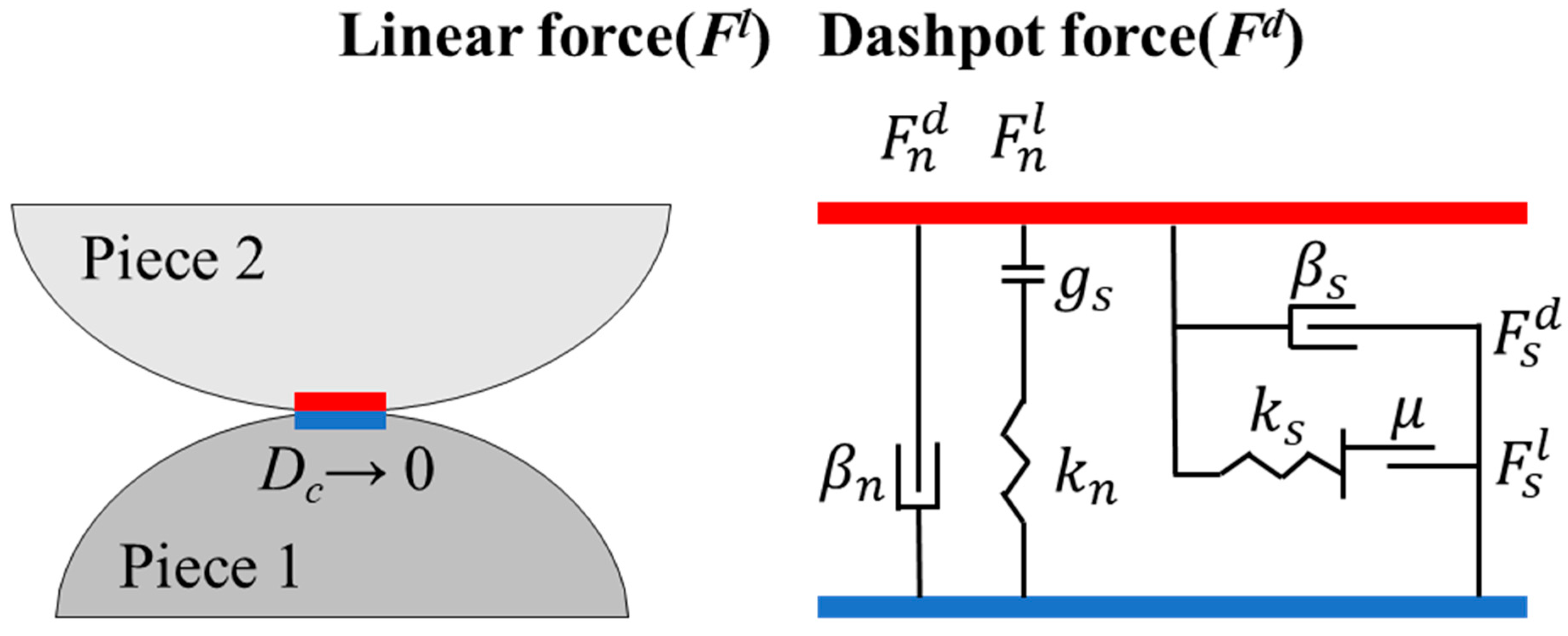
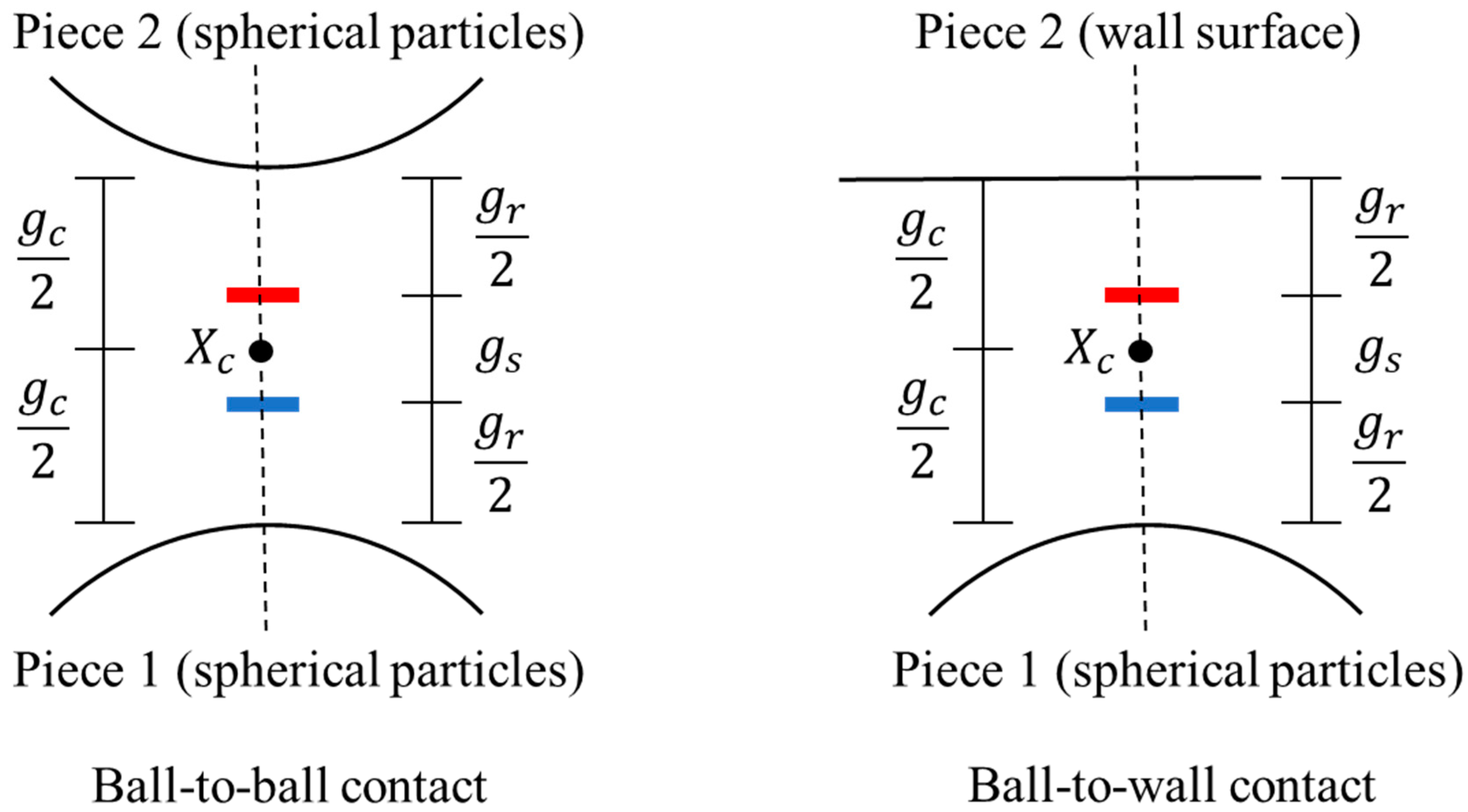

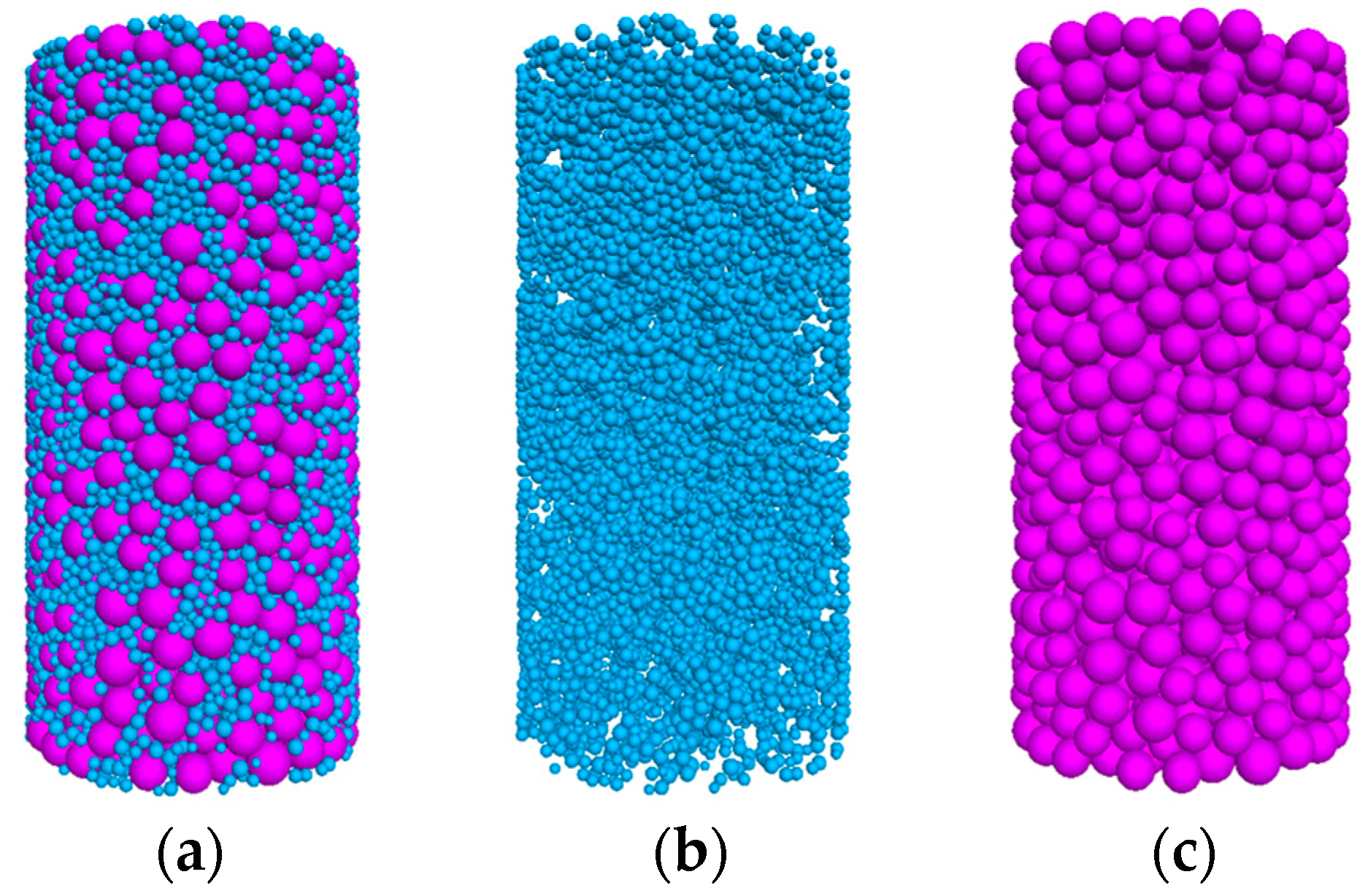
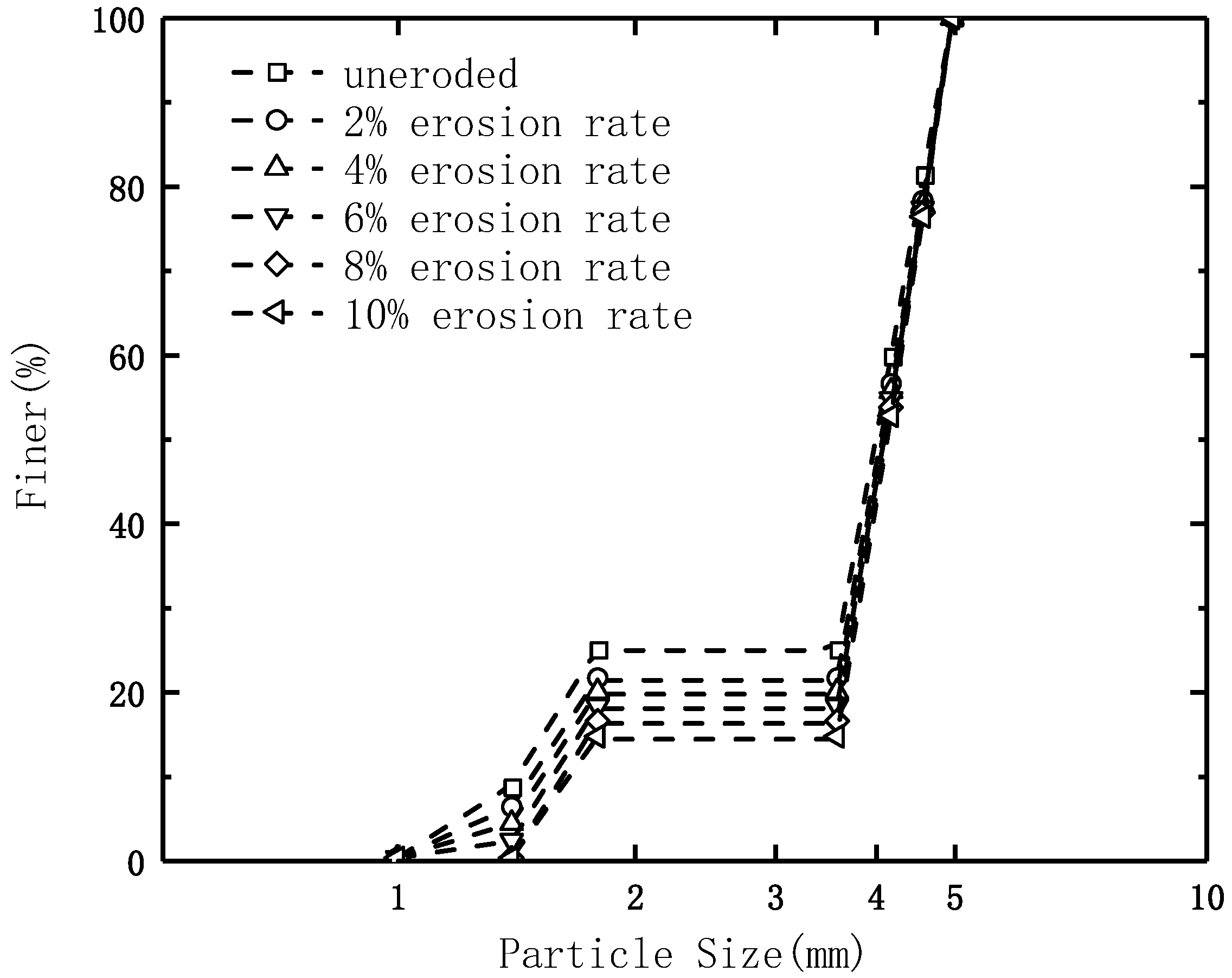
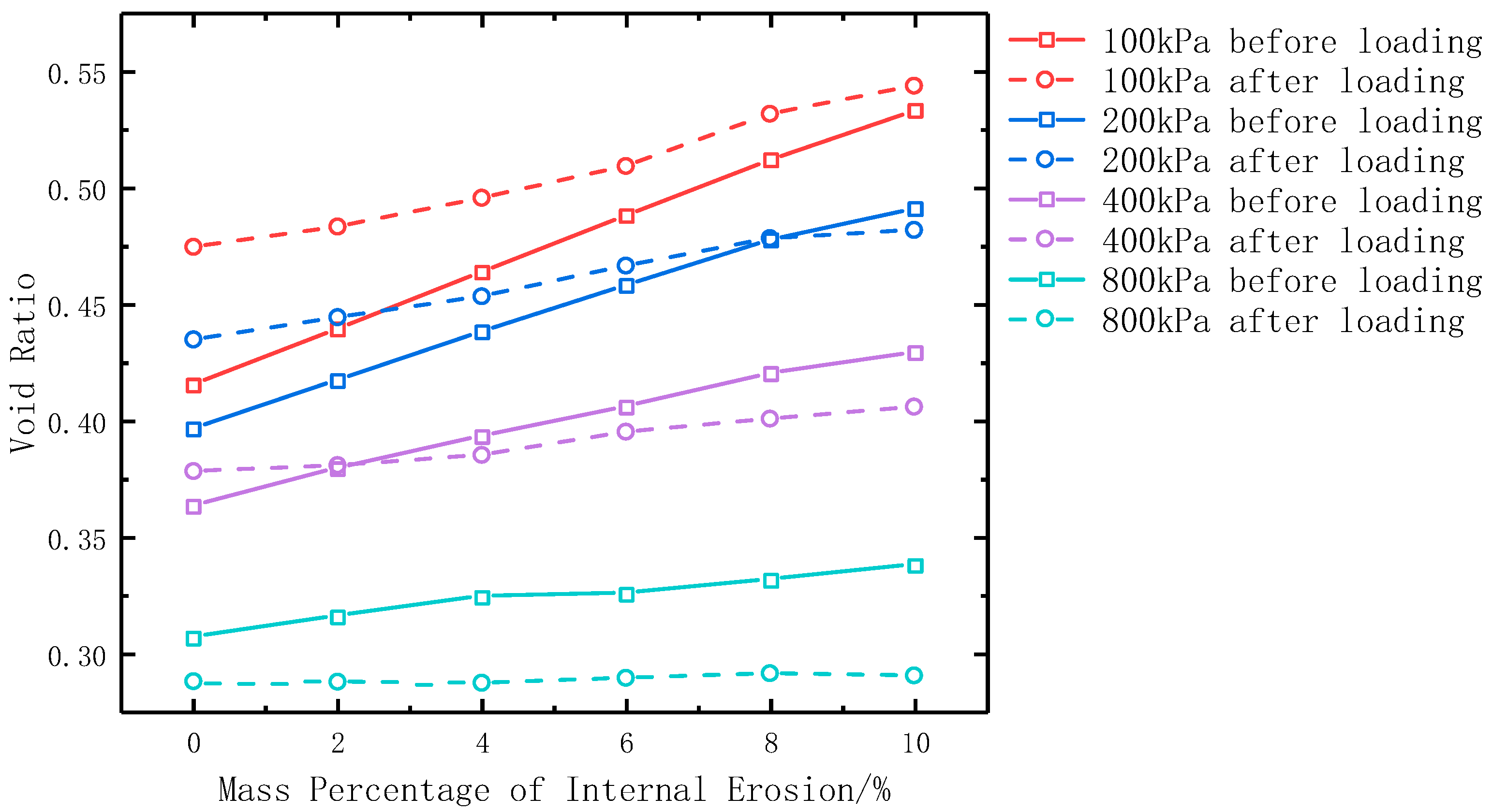

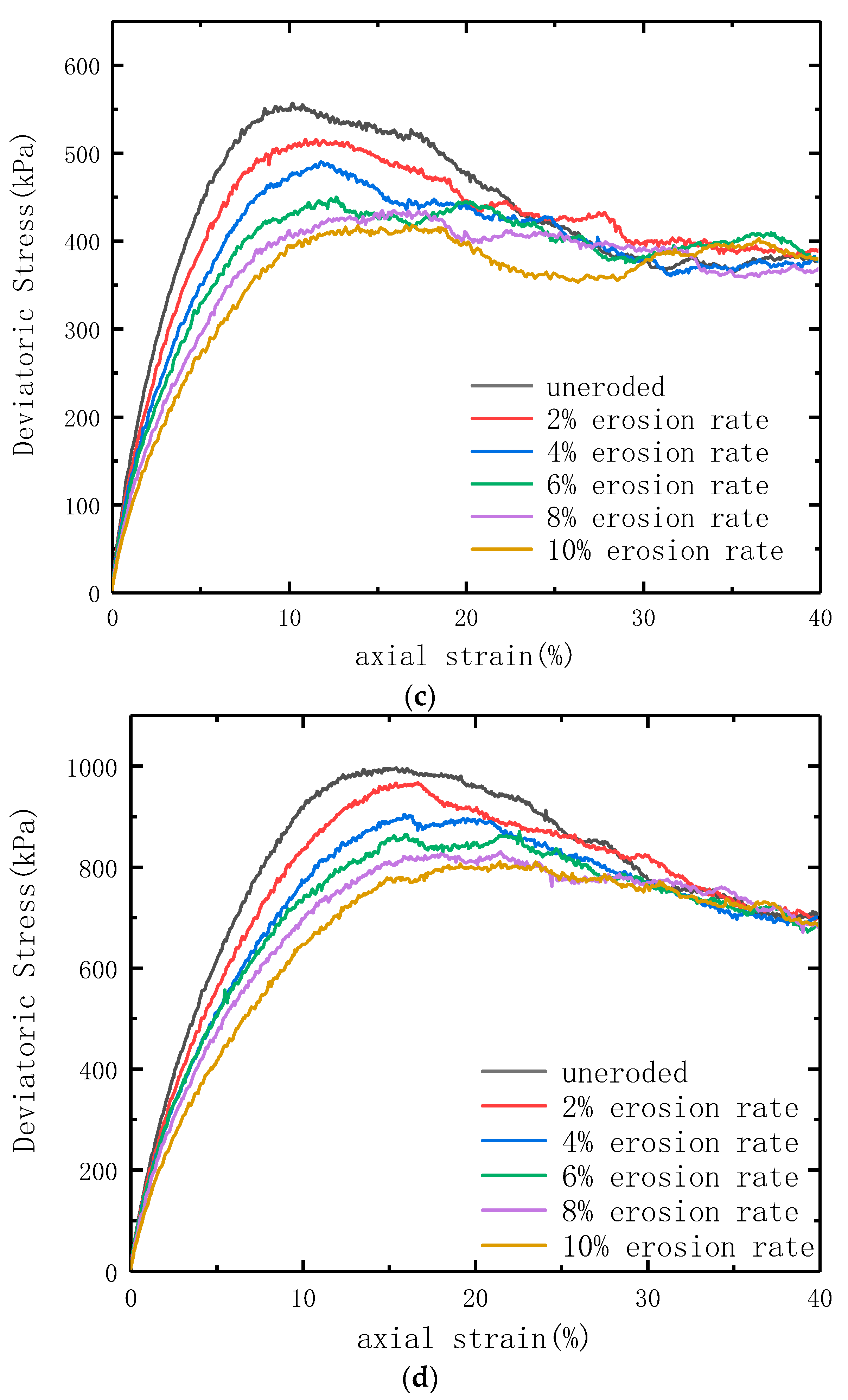
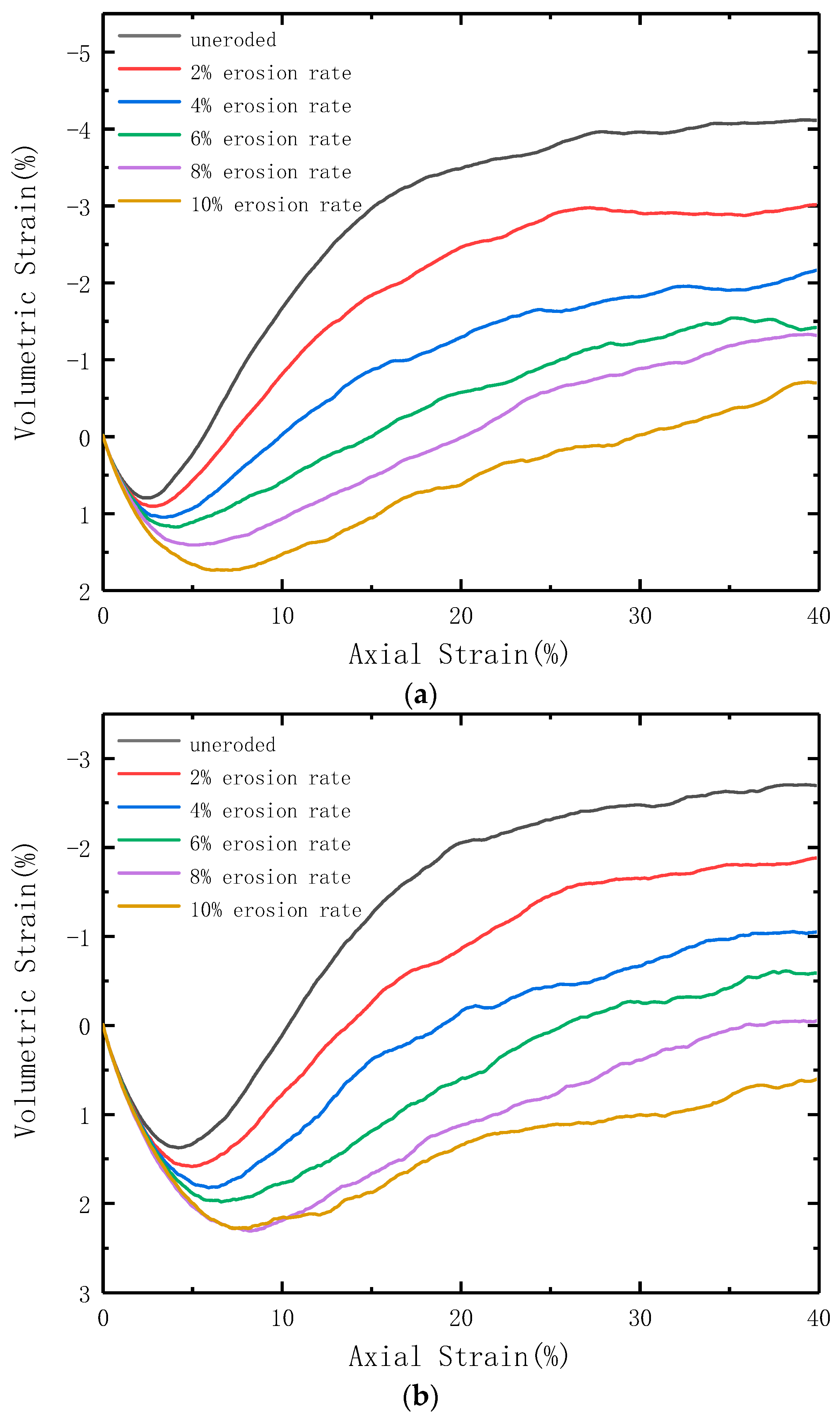
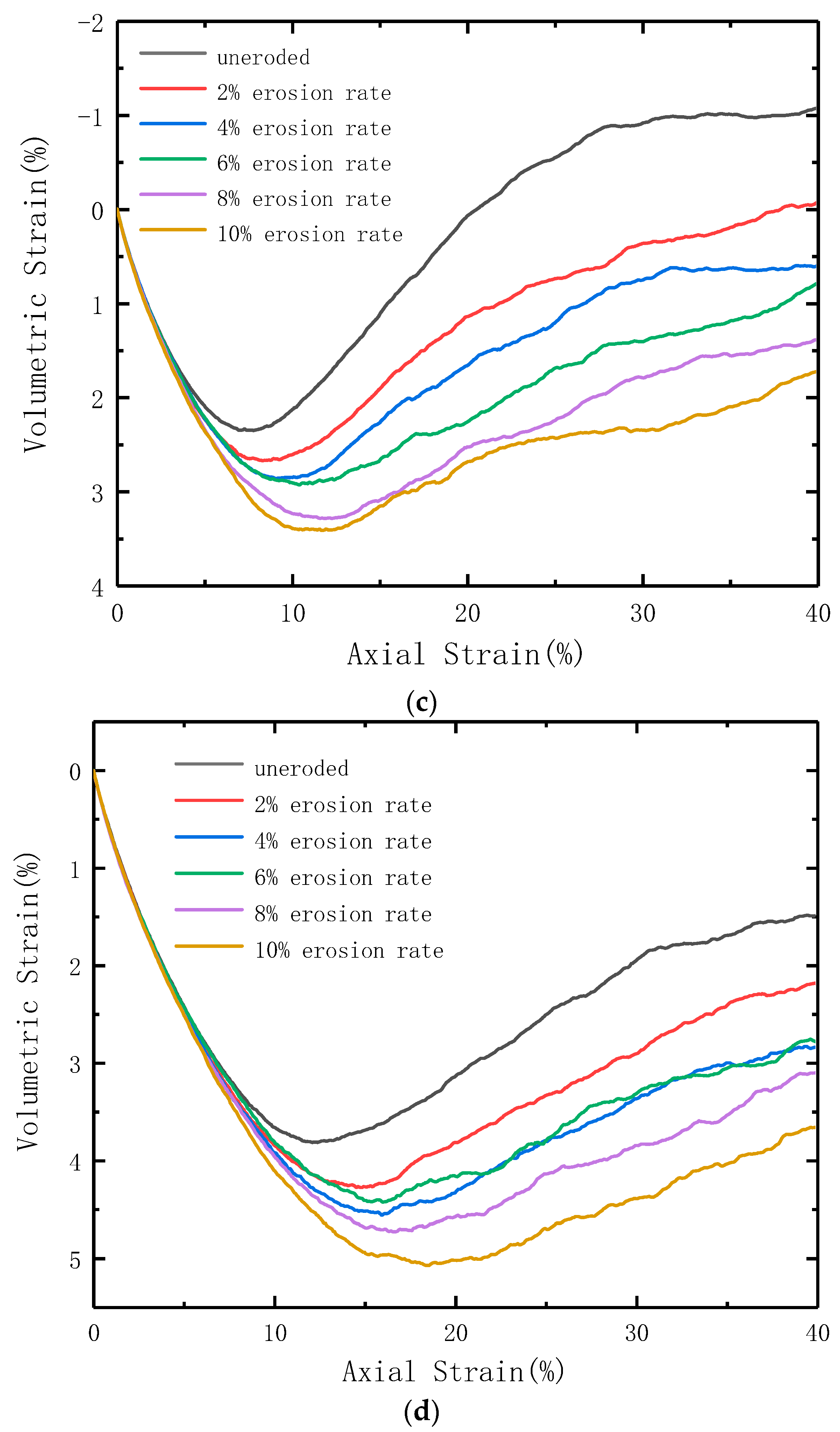
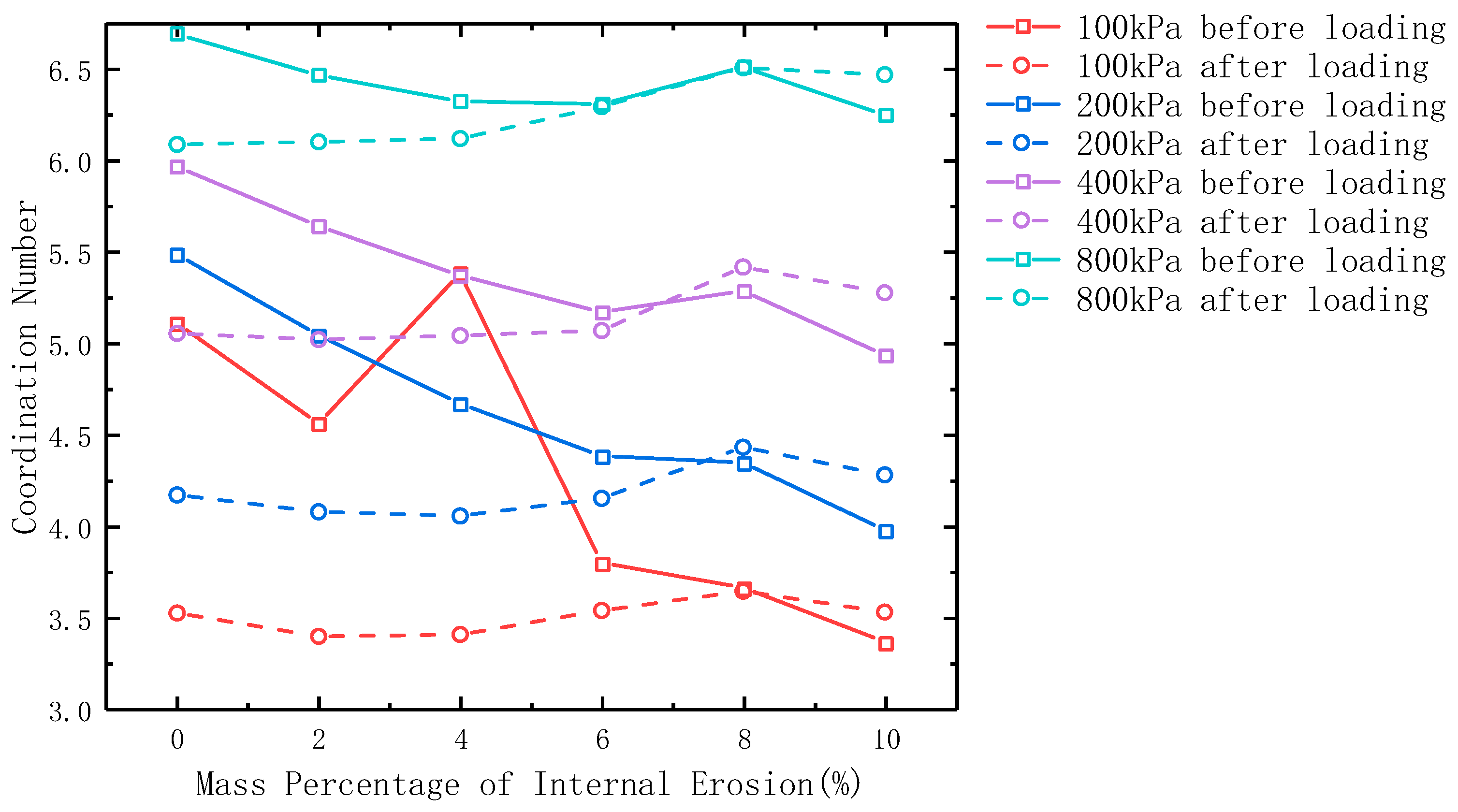
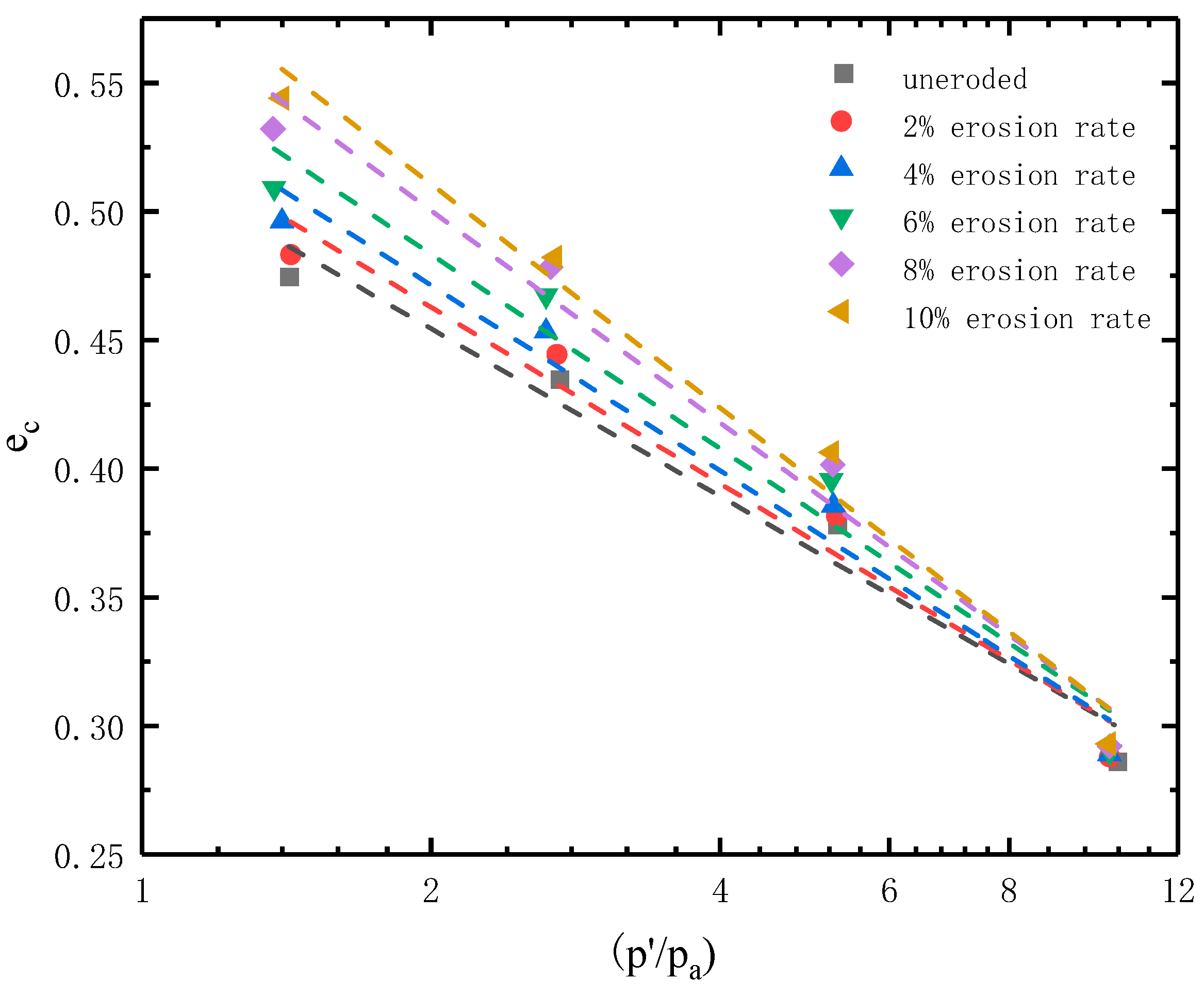
| Model Parameters | Value |
|---|---|
| Particle density (kg/m3) | 2.65 |
| Normal stiffness of particles | 8 × 104 |
| Tangential stiffness of particles | 7 × 104 |
| Damping factor of particles | 0.7 |
| Friction coefficient of particles | 0.2 |
| Normal stiffness of walls | 1 × 108 |
| Degree of Erosion | 0% | 2% | 4% | 6% | 8% | 10% |
|---|---|---|---|---|---|---|
| 0.5345 | 0.5476 | 0.5612 | 0.5796 | 0.6045 | 0.6182 | |
| 0.0484 | 0.0512 | 0.0539 | 0.0571 | 0.0620 | 0.0648 | |
| R2 | 0.9992 | 0.9997 | 0.9983 | 0.9997 | 0.9969 | 0.9938 |
Disclaimer/Publisher’s Note: The statements, opinions and data contained in all publications are solely those of the individual author(s) and contributor(s) and not of MDPI and/or the editor(s). MDPI and/or the editor(s) disclaim responsibility for any injury to people or property resulting from any ideas, methods, instructions or products referred to in the content. |
© 2023 by the authors. Licensee MDPI, Basel, Switzerland. This article is an open access article distributed under the terms and conditions of the Creative Commons Attribution (CC BY) license (https://creativecommons.org/licenses/by/4.0/).
Share and Cite
Li, M.-W.; Hu, S.-L.; Tong, C.-X. Numerical Simulation of Mechanical Properties of Soil Considering the Effect of Internal Erosion. Mathematics 2023, 11, 2959. https://doi.org/10.3390/math11132959
Li M-W, Hu S-L, Tong C-X. Numerical Simulation of Mechanical Properties of Soil Considering the Effect of Internal Erosion. Mathematics. 2023; 11(13):2959. https://doi.org/10.3390/math11132959
Chicago/Turabian StyleLi, Mao-Wen, Sheng-Liang Hu, and Chen-Xi Tong. 2023. "Numerical Simulation of Mechanical Properties of Soil Considering the Effect of Internal Erosion" Mathematics 11, no. 13: 2959. https://doi.org/10.3390/math11132959
APA StyleLi, M.-W., Hu, S.-L., & Tong, C.-X. (2023). Numerical Simulation of Mechanical Properties of Soil Considering the Effect of Internal Erosion. Mathematics, 11(13), 2959. https://doi.org/10.3390/math11132959








